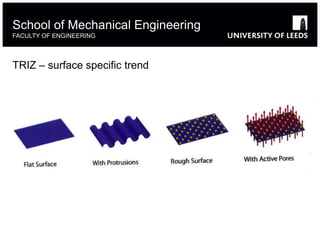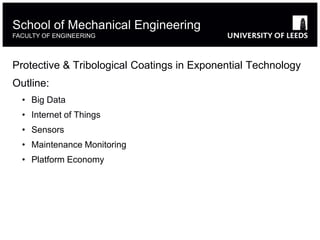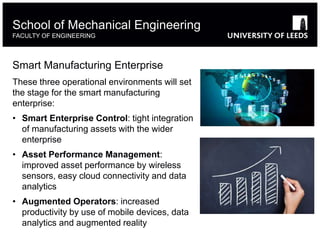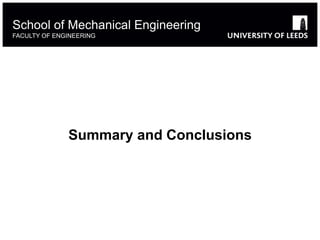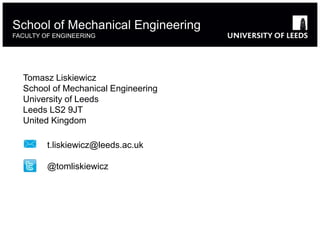Surface Ventures: What Exponential Growth of Technology means for Tribological Coatings
- 1. School of something FACULTY OF OTHER School of Mechanical Engineering FACULTY OF ENGINEERING Surface Ventures What Exponential Growth of Technology means for Tribological Coatings Tomasz Liskiewicz, Institute of Functional Surfaces Keynote Lecture 15th International Conference on Plasma Surface Engineering Sept 12-16, 2016, Garmisch-Partenkirchen, Germany
- 2. Outline ŌĆó Exponential Growth ŌĆó Global Technology Trends ŌĆó Protective and Tribological Coatings ŌĆó Summary and Conclusions School of Mechanical Engineering FACULTY OF ENGINEERING
- 3. Exponential Growth School of Mechanical Engineering FACULTY OF ENGINEERING
- 4. Linear 1, 2, 3, 4, 5, 6ŌĆ” ŌĆó 30 linear steps: end up about 30 meter away Exponential 1, 2, 4, 8, 16, 32ŌĆ” ŌĆó 30 exponential steps: billion meters away (26 times around the planet) School of Mechanical Engineering FACULTY OF ENGINEERING
- 5. Knowledge grows exponentially ŌĆó The more we know the greater our ability to learn ŌĆó The greater our ability to learn the faster we expand our knowledge base ŌĆó Growth of knowledge fuels growth of technology ŌĆó Each new scientific discovery becomes a tool with which novel technologies are invented ŌĆó Technology feeds on itself School of Mechanical Engineering FACULTY OF ENGINEERING
- 6. Law of accelerating returns ŌĆó Every generation of technology stands on the shoulders of the last generation of technology ŌĆó We use our best tools to build even better ones ŌĆó The rate of progress continues to speed up from version to version School of Mechanical Engineering FACULTY OF ENGINEERING ŌĆ£TranscendenceŌĆØ (2014)ŌĆ£The Singularity is NearŌĆØ Ray Kurzweil (2005)
- 7. Technology feels like it is accelerating, because it actually is ŌĆó MooreŌĆÖs Law ŌĆó Exponential rise of integrated circuits ŌĆó Processing power doubles every two years ŌĆó Cost decreases at the same rate ŌĆó Related technologies/industries driven by computing speed and power School of Mechanical Engineering FACULTY OF ENGINEERING
- 8. School of Mechanical Engineering FACULTY OF ENGINEERING
- 9. School of Mechanical Engineering FACULTY OF ENGINEERING http://content.time.com/time/interactive/0,31813,2048601,00.html
- 10. Exponential growth of computing based technology ŌĆó 40 years ago: one computer took up a whole building ŌĆó Today: the computer in your cell phone is a million times cheaper and a thousand times more powerful ŌĆó In 20 years: what fits in your pocket now will fit into a blood cell and will again be millions of times more cost effective School of Mechanical Engineering FACULTY OF ENGINEERING
- 11. Human genome project ŌĆó Started in 1990 ŌĆó After 7.5 years: only 1% was completed ŌĆó Sceptics were predicting 100 years to complete ŌĆó Ray Kurzweil predicted: 15 years ŌĆó Genome successfully sequenced in 2003 School of Mechanical Engineering FACULTY OF ENGINEERING singularity.com
- 12. School of Mechanical Engineering FACULTY OF ENGINEERING singularity.com
- 13. Internet bandwidth School of Mechanical Engineering FACULTY OF ENGINEERING
- 14. How to think exponentially School of Mechanical Engineering FACULTY OF ENGINEERING
- 15. Exponential growth surprise factor ŌĆó Exponential growth radically different from our intuition ŌĆó Intuition about the future hardwired in our brains School of Mechanical Engineering FACULTY OF ENGINEERING singularityhub.com
- 16. Technology Trends School of Mechanical Engineering FACULTY OF ENGINEERING
- 17. Ray KurzweilŌĆÖs predictions in 2016 ŌĆó The genetics revolution will allow us to reprogram our own biology ŌĆó The nanotechnology revolution will allow us to manipulate matter at the molecular and atomic scale ŌĆó The robotics revolution will allow us to create a greater than human non- biological intelligence School of Mechanical Engineering FACULTY OF ENGINEERING
- 18. The industries of the future, Alec Ross (2015) ŌĆó Explores the next waves of innovation in robotics, genetics, coding and big data and how they will affect our world ŌĆó Trends covered: ŌĆó Robotics ŌĆó Advanced Life Sciences ŌĆó Code-ification of Money ŌĆó Cybersecurity ŌĆó Big Data School of Mechanical Engineering FACULTY OF ENGINEERING
- 19. School of Mechanical Engineering FACULTY OF ENGINEERING What Technology Wants, Kevin Kelly (2010) The Inevitable, Kevin Kelly (2016) ŌĆó Technology in a wider context of human evolution ŌĆó Human evolution with technology has been a trend of improvement ŌĆó Technology is like a living organism ŌĆó Technology has its own needs
- 20. Deloitte: Tech Trends 2016 (Innovation in the Digital Era) ŌĆó Right-speed IT ŌĆó Augmented & virtual reality go to work ŌĆó Internet of Things: From sensing to doing ŌĆó Reimagining core systems ŌĆó Autonomic platforms ŌĆó Blockchain: Democratized trust ŌĆó Industrialized analytics ŌĆó Social impact of exponential technologies School of Mechanical Engineering FACULTY OF ENGINEERING
- 21. Biomimetics ŌĆō trend towards ideality School of Mechanical Engineering FACULTY OF ENGINEERING
- 22. Biomimetics ŌĆō friction in nature School of Mechanical Engineering FACULTY OF ENGINEERING 10-6 (1╬╝m) 10-7 (100nm=0.1╬╝m) 10-5 (10╬╝m) 10-4 (100╬╝m=0.1mm) 10-3 (1mm) 10-2 (10mm) 10-1 (100mm=0.1m) 100 (1m) 101 (10m) 102 (100m=0.1km) 103 (1km) 104 (10km) a b c d e f g h i j k l m n o p s r T Liskiewicz et al, Friction in Nature, WIT Transactions on Ecology and the Environment, 2008
- 23. TRIZ ŌĆó TRIZ: Theory of Inventive Problems Solving ŌĆó Teoriya Resheniya Izobreatatelskikh Zadach ŌĆó TRIZ message: Innovation Can Be Codified ŌĆó There are universal principles of invention that are the basis for creative innovations that advance technology ŌĆó If these principles are identified and codified, they can be taught to make the process of invention more predictable School of Mechanical Engineering FACULTY OF ENGINEERING
- 24. TRIZ ŌĆó Using the knowledge and experience of former inventors ŌĆó 2m patents studied by AltshullerŌĆÖs team ŌĆó 5m (?) patents studied up to date ŌĆó Problems and solutions were repeated across industries ŌĆó Patterns of technical evolution were repeated across industries ŌĆó Innovations can use scientific effects outside the field where they were developed School of Mechanical Engineering FACULTY OF ENGINEERING Genrich Altshuller
- 25. TRIZ trends ŌĆó Prediction where the systems will evolve in the future ŌĆó Indication of the most likely successful future direction ŌĆó Assessment and development of intellectual property School of Mechanical Engineering FACULTY OF ENGINEERING Immobile system Joint Multiple joints Completely elastic Liquid/ gas Field
- 26. TRIZ ŌĆō surface specific trend School of Mechanical Engineering FACULTY OF ENGINEERING
- 27. Protective & Tribological Coatings in the context of Exponential Technology School of Mechanical Engineering FACULTY OF ENGINEERING
- 28. Protective & Tribological Coatings in Exponential Technology Outline: ŌĆó Big Data ŌĆó Internet of Things ŌĆó Sensors ŌĆó Maintenance Monitoring ŌĆó Platform Economy School of Mechanical Engineering FACULTY OF ENGINEERING
- 29. Big Data ŌĆó Land was the raw material of the agricultural age ŌĆó Iron was the raw material of the industrial age ŌĆó Data is the raw material of the information age 90% of the worldŌĆÖs digital data has been generated over the last two years Big Data term describes how these large amounts of data can now be used to understand, analyse, and forecast trends in real time. The industries of the future, Alec Ross (2015) School of Mechanical Engineering FACULTY OF ENGINEERING
- 30. Smart Manufacturing Enterprise These three operational environments will set the stage for the smart manufacturing enterprise: ŌĆó Smart Enterprise Control: tight integration of manufacturing assets with the wider enterprise ŌĆó Asset Performance Management: improved asset performance by wireless sensors, easy cloud connectivity and data analytics ŌĆó Augmented Operators: increased productivity by use of mobile devices, data analytics and augmented reality School of Mechanical Engineering FACULTY OF ENGINEERING
- 31. Industrial Internet of Things ŌĆó Connected assets operate as part of a larger system that make up the smart manufacturing enterprise ŌĆó The assets possess varying levels of intelligent functionality (from simple sensing and actuating, to control, optimisation and full autonomous operation) ŌĆó Consumer IoT: moderate value so far (nice to have solutions) ŌĆó Commercial IoT: real business value School of Mechanical Engineering FACULTY OF ENGINEERING
- 32. School of Mechanical Engineering FACULTY OF ENGINEERING http://www.visualcapitalist.com/industrial-internet-things-next-big-growth-driver/
- 33. School of Mechanical Engineering FACULTY OF ENGINEERING Quick adoption of internet related technologies ŌĆó 100 million people travelled by air: 70 years after invention of the airplane ŌĆó 100 million people to use telephone: 50 years ŌĆó 100 million PC users: 14 years ŌĆó 100 million Internet users: 7 years ŌĆó Facebook acquired 100 million users in 2 years
- 34. Sensors ŌĆō the nervous system of the IIoT ŌĆó Small, cheap, many of them ŌĆó 1000ŌĆÖs of sensors vs. a technician with a gauge (data resolution) ŌĆó Single performance tasks linked to complex analytical models (temperature, vibration, acoustics) ŌĆó E.g. fiber optic systems available collecting spatially continuous strain and temp. data along the length of the fiber in real time ŌĆó Towards smart sensors with autonomous learning capability (more data more finely tuned) School of Mechanical Engineering FACULTY OF ENGINEERING
- 35. The immediate business need (Case Study) ŌĆó ABB sensors package for low-voltage motors ŌĆó No additional infrastructure (incorporated battery & storage) ŌĆó Technician syncs data wirelessly ŌĆó Downtime reduced up to 70% ŌĆó Preventive maintenance extends life of the motor by 30% ŌĆó Improve motor efficiency by 10% School of Mechanical Engineering FACULTY OF ENGINEERING machinedesign.com
- 36. ŌĆ£Neural dustŌĆØ sensor/implant (Case Study) ŌĆó 2x1mm, battery-less ŌĆó Can monitor internal nerves, muscles or organs in real time ŌĆó Temperature, pressure, oxygen, pH ŌĆó Fit-bit like device ŌĆó Also stimulate nerves and muscles School of Mechanical Engineering FACULTY OF ENGINEERING UC Bercley ScienceNews, Aug 8, 2016
- 37. Maintenance Monitoring ŌĆó Maintenance 1.0: wait until it breaks ŌĆó Maintenance 2.0: monitoring maintenance (determine breakdown by oil, vibration, thermal analysis etc.) ŌĆó Maintenance 3.0: predictive maintenance (asset management along with more improved condition- based techniques) ŌĆó Maintenance 4.0: proactive maintenance (sensors, data analysis, determination of trends) School of Mechanical Engineering FACULTY OF ENGINEERING
- 38. New Economy: from Product to Platforms School of Mechanical Engineering FACULTY OF ENGINEERING Accenture, Technology Vision 2016, Trend 3: Platform Economy
- 39. Advanced Materials Systems Framework ŌĆó Materials technologies move beyond the frontier of new molecules and materials ŌĆó Value creation through functional solutions ŌĆó Leveraging inventive combinations of: ŌĆó Materials ŌĆó Process technologies ŌĆó Business models ŌĆó Partnerships ŌĆó Collaborations School of Mechanical Engineering FACULTY OF ENGINEERING Deloitte Touche Tohmatsu Limited Global Manufacturing Industry Group
- 40. Cost of missing the trend: Kodak ŌĆó 1996: $28 billion market cap and 140,000 employees ŌĆó 2012: Kodak filed for bankruptcy School of Mechanical Engineering FACULTY OF ENGINEERING singularityhub.com
- 41. Summary and Conclusions School of Mechanical Engineering FACULTY OF ENGINEERING
- 42. Summary and conclusions In the not-too-distant future, billions of smart things in the physical world will be sensing, responding, communicating and sharing data ŌĆó Surface Ventures: studying engineering surfaces in the context of the exponential growth of technology ŌĆó Moving from passive coating to connected-sensing-responsive surface ŌĆó Surface engineering progress fuelled by trends: digitalisation, nanotechnology, platform solutions, biomimetics School of Mechanical Engineering FACULTY OF ENGINEERING
- 43. Summary and conclusions ŌĆó The potential of IoT lies in the ability to link automation systems with enterprise planning and product life cycle systems ŌĆó Simple measurements BUT deep analytics (underpinned by tribological models) ŌĆó Predictive maintenance, improved operational efficiency ŌĆó Businesses will pay a high cost of not paying close attention to technology trends School of Mechanical Engineering FACULTY OF ENGINEERING
- 44. The future has many names: For the weak, it means the unattainable. For the fearful, it means the unknown. For the courageous, it means opportunity. - Victor Hugo School of Mechanical Engineering FACULTY OF ENGINEERING I skate to where the puck is going to be, not where it has been. - Wayne Gretzky
- 45. School of Mechanical Engineering FACULTY OF ENGINEERING t.liskiewicz@leeds.ac.uk @tomliskiewicz Tomasz Liskiewicz School of Mechanical Engineering University of Leeds Leeds LS2 9JT United Kingdom


























